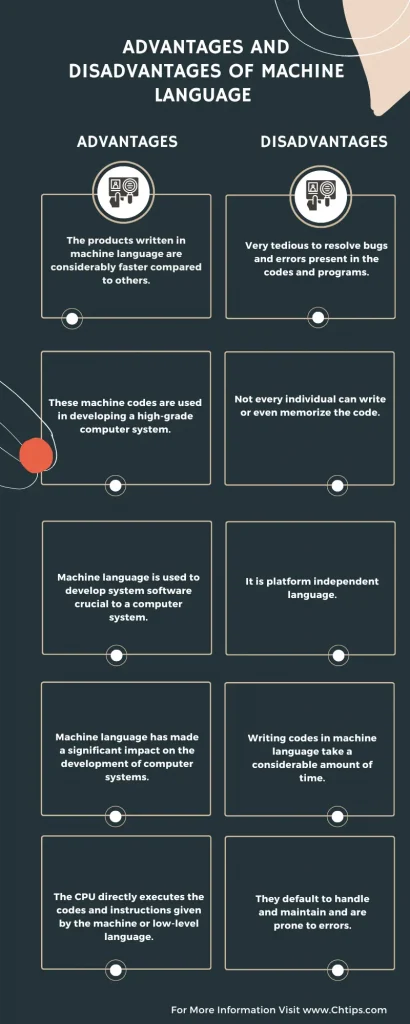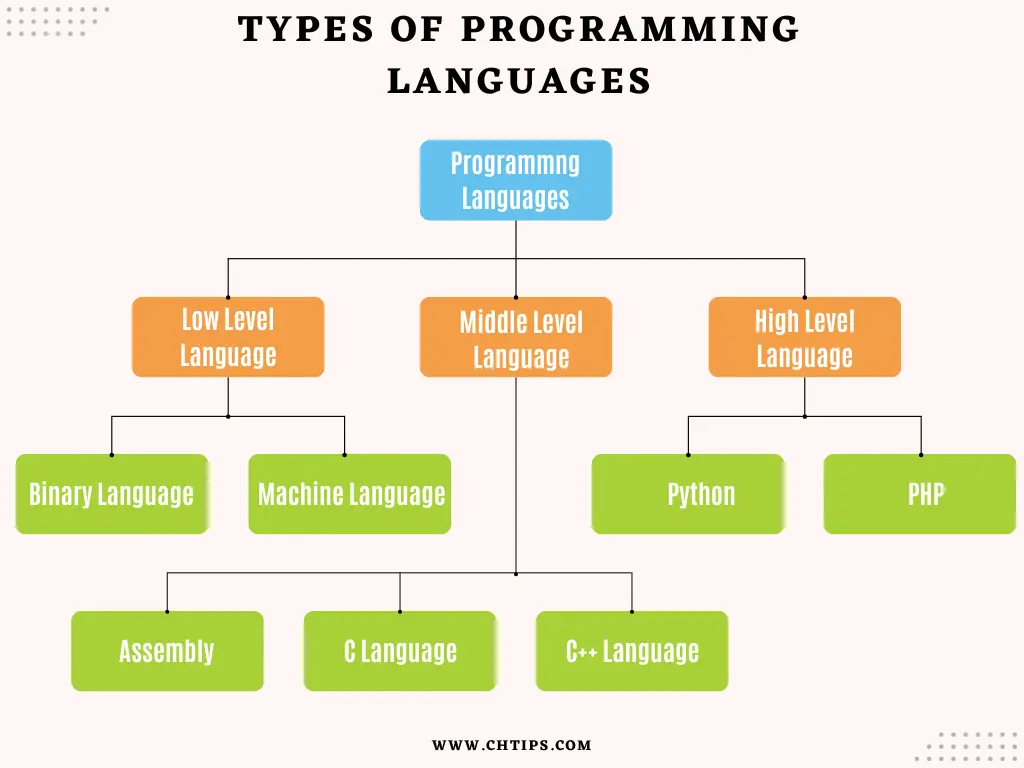The machine language is also called “Low-Level Programming Language” and “Binary Language”.
Machine language was extensively used in the first generation of computers. Machine language is the first language used to develop a high-end computer system.
This language was used and preferred by most large organizations; still, there are some significant advantages and disadvantages of machine language.
What is Machine Language?
Machine language is a low-level programming language that includes and uses 0s and 1s. Computers are not capable of reading and understanding other languages except machine language.
Machine language is far more challenging to learn and execute.
Machine language is a computer programming language used for developing computers; this language was used in the first and second generations of computers.
This machine language does not need translation as it is already written and compiled in binary language, which is easily understood by a computer system.
The bugs and errors in low-level language cannot be quickly figured out and are very tedious to resolve.
Computer languages use a compiler, interpreter, and translator for functioning and execution.
Machine language works in two distinct methods.
- Opcode
- Location Counter
An opcode is responsible for transferring data and information to computers.
Location Code: It represents and presents information for storing data and information.
Various programming languages are available to write programming codes, like C, C+=, Python, Visual Basic, Ruby, etc.
Examples of Machine Language
Chtips.com
01000011 01101000 01110100 01101001 01110000 01110011 00101110 01100011 01101111 01101101
Advantages and Disadvantages of Machine Language | Benefits and Drawbacks of Machine Language

Advantages and Disadvantages of Machine Language in Tabular Form
| # | Machine Language Advantages | Machine Language Disadvantages |
| 1 | The machine language | low-level language does not require translation as they are already written in binary language, i.e. 0s and 1s, which is easily understood by the computer system. This language is extensively used in the first generation of computers. | The major disadvantage of machine language is that the codes and programs are complicated to write, memorize and execute. |
| 2 | The products written in machine language are considerably faster compared to others. | Very tedious to resolve bugs and errors present in the codes and programs. |
| 3 | These machine codes are used in developing a high-grade computer system. | Not every individual can write or even memorize the code. |
| 4 | Machine language is used to develop system software crucial to a computer system. | It is platform independent language. |
| 5 | Machine language has made a significant impact on the development of computer systems. | Writing codes in machine language take a considerable amount of time. |
| 6 | The CPU directly executes the codes and instructions given by the machine or low-level language. | They default to handle and maintain and are prone to errors. |
| 7 | The code and program written in machine language are executed quickly as they are in binary format. | It isn’t easy to modify. |
| 8 | Machine language does not require a translator. | The numerical form of instructions is difficult to remember and leads the errors. |
| 9 | In machine language sequence of bits is used to give commands and instructions, whereas 0 represents false or off state and 1 represents on or true state. | The codes written in machine language are not reusable. |
| 10 | Machine Language is responsible for the evolution of computer systems and operating systems. | Machine language is a challenging and complex programming language to learn and execute. |
Useful Video On: Machine Language Advantages and Disadvantages
What are the Features of Machine Language?
There are several features of machine language that are stated below
- Machine language is also called “Low-Level Language.”
- Machine language works with binary digits like 0s and 1s.
- The binary need not translate as computers easily understand them.
- They were extensively used in the first generation of computers.
- They are challenging to learn and execute.
- The development time taken to write and compile a program was considerably high.
Different Types of Computer Language

- Machine Language.
- Assembly Language.
- High-Level Language.
4 Types of Programming Language
- Procedural Programming Language
- Functional Programming Language
- Scripting Programming Language
- Logic Programming Language
- Object-Oriented Programming Language [OOPs]
6 Uses of Machine Language
- The computer cannot understand human languages or codes; therefore, it needs to translate this code or language into a machine-readable form that is 0s and 1s. This language is called machine language or Binary Language.
- Machine languages were used in the first generation of computers to develop system software.
- Machine language is converted to human readable language with the help of a compiler and translator.
- Operation systems and other system software were developed with the help of machine language.
- Device drivers are also designed and developed with the help of machine language.
- Language Compilers, Assemblers, Text Editors, Print Spoolers, Network Drivers, Modern Programs, Databases, and Language Interpreters are developed with the help of machine language or low-level programming language like C programming.
Machine Language vs Assembly Language
| # | Machine Language | Assembly Language |
| 1 | A machine language consists of 0s and 1s | Assembly language is a similar syntax to the English language |
| 2 | Normal individuals cannot understand machine language. | It is easy to understand assembly language. |
| 3 | Machine language is used in the first generation of computers. | Assembly language is used in the second generation of computers. |
| 4 | Machine language does not require a translator. | Assembly language requires a translator. |
| 5 | Modification and update are not possible | Modification and updating are not that difficult. |
Programming Language Launched Date & Uses
| # | Programming Language | Uses | Launched Year |
| 1 | C | Device Drivers and Operating System | 1972 |
| 2 | C++ | Games, Video, and Picture Editing Software. | 1985 |
| 3 | Python | Artificial Intelligence and Machine learning | 1991 |
| 4 | PHP | Application Development, Software. | 1995 |
| 5 | .NET | Desktop Software and Application Software. | 2001 |
| 6 | JAVA | Enterprise Application Development | 1996 |
| 7 | JavaScript | Rich Interactive Web Applications | 1995 |
| 8 | Jquery | It is a framework of javascript used to add extra functionality to webpages. | 2006 |
| 9 | SQL | Database Management | 1979 |
Different Programming Languages With Purpose
| # | Programming Language | Uses |
| 1 | C | Device Drivers and Operating System |
| 2 | C++ | Games, Video, and Picture Editing Software. |
| 3 | Python | Artificial Intelligence and Machine learning |
| 4 | PHP | Application Development, Software. |
| 5 | .NET | Desktop Software and Application Software. |
| 6 | JAVA | Enterprise Application Development |
| 7 | JavaScript | Rich Interactive Web Applications |
| 8 | Jquery | It is a framework of javascript used to add extra functionality to webpages. |
| 9 | SQL | Database Management |
Is Python a Machine Language
Python is an example of a high-level language
Is C++ a Machine Language
C++ is considered to be a low-level programming language
Is Machine Language Hard To Learn
Yes, Machine language is complicated to learn and execute.
People Are Also Reading
- Characteristics of Object Oriented Programming Languages
- Advantages and Disadvantages of PHP
- Advantages and Disadvantages of Assembly Language
- Advantages and Disadvantages of Low Level Language
- Why is C++ So Hard to Learn For Beginners
- What are the Importance of C Programming Language
- What Language is YouTube Written in
- Is Python Written in C
- Structure of HTML Document With Examples
- What is PLC [Programmable Logic Controller]
- 10+ Advantages and Disadvantages of High-Level Languages
- Advantages and Disadvantages of Subroutines
- C Programming Tutorials
- Computer Basic Tutorials
Frequently Asked Questions [FAQs]
Why is Machine Language called Binary Language?
Machine-level language is also called “Low-Level Language”. It works with 0s and 1s; therefore, it is known as “Binary Language”.
Is Machine Language a Low-Level Language?
Machine Language and Assembly Language are the two well-known low-level languages.
What is Machine Programming?
Machine programming is used in the development, maintenance and automation of software.
Is Machine Language Faster than Assembly Language?
Machine language is faster and more advanced than assembly language.
Who Created Machine Language?
The first programming language was developed in 1883 when Ada Lovelace and Charles Babbage worked together on the Analytical and Differential engines.
What is the 1st Programming Language?
FORTRAN [Formula Translation] is one of the oldest programming languages designed and developed by John Backus in 1957.
2 Major Advantages of Machine Language
Machine language is used to develop system software.
The software developed in machine language is faster in processing.
2 Disadvantages of Machine Language
Machine language is difficult to write, memorize and learn.
Difficult to modify the code written in machine language.
Get In Touch
I have also written and compiled some articles on computers and telecommunications, and please go through them.
I hope you will like reading it.
I hope all the questions and queries related to 10 Advantages and Disadvantages of Machine Language | Benefits and Drawbacks of Machine Language with examples and images have been answered here.
If you have any questions about the Pros and Cons of Machine Language.
Don’t hesitate to contact me, and if you need to add, remove or update anything from the article, please let me know in the comment section or via email.
I will be more than happy to update the article. I am always ready to correct myself.
Please share this article with your friends and colleagues; this motivates me to write more on related topics.
!!! Thank You !!!